
Stanhopea is a genus of the orchid family (Orchidaceae) from Central and South America. The abbreviation used in horticultural trade is Stan. The genus is named for the 4th Earl of Stanhope (1781-1855), president of the Medico-Botanical Society of London (1829-1837). It comprises 55 species and 5 natural hybrids. These epiphytic, but occasionally terrestrial orchids can be found in damp forests from Mexico to Trinidad to NW Argentina. Their ovate pseudobulbs carry from the top one long, plicate, elliptic leaf.
Rhodothyrsus is a plant genus of the family Euphorbiaceae, first described as a genus in 1999. It is native to South America.
- Rhodothyrsus hirsutusEsser - Colombia, NW Venezuela
- Rhodothyrsus macrophyllus(Ducke) Esser - Guyana, Suriname, Colombia, Peru, N Brazil
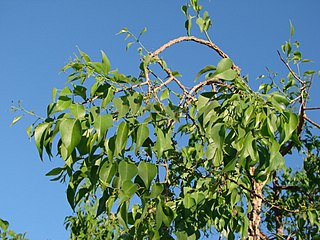
Agonandra is a genus of plants in the family Opiliaceae described as a genus in 1862.

Dalechampia dioscoreifolia is a species of plant in the family Euphorbiaceae first described in 1841. It is native to Central America and northern and western South America.

Brunellia is a genus of trees. They are distributed in the mountainous regions of southern Mexico, Central America, West Indies, and South America. Brunellia is the only genus in the family Brunelliaceae. As of 2001 there were about 54 species.

Renealmia is a plant genus in the family Zingiberaceae. Its members are native to tropical Africa and tropical America. In Peru, fruits and tubers are sources of indigenous dyes. and indigenous medical treatments for leishmania and malaria In Colombia, it is used to treat snakebite. Bracts and leaves can serve as phytotelmata, retaining small quantities of water that offer habitat for other organisms.

Rhodospatha is a genus of plant in family Araceae. It is native to South America, Central America, and southern Mexico.
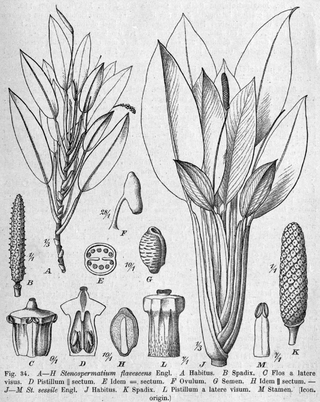
Stenospermation is a genus of plant in family Araceae native to South America and Central America.
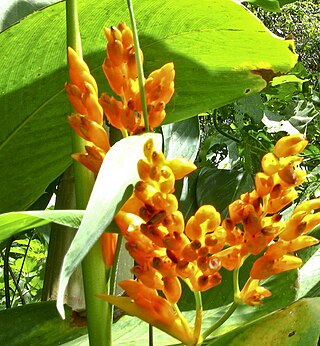
Stromanthe is a genus of flowering plants in the family Marantaceae, native to the tropical portions of the Americas from Mexico to Trinidad to northern Argentina.

Sievekingia is a genus of orchid, comprising 20 species found in Central and South America, from Nicaragua east to the Guianas and south to Bolivia.

Ctenanthe is a genus of flowering plants of the family Marantaceae described as a genus in 1884. They are evergreen perennials, native to Central and South America. They are grown for their attractive, often variegated foliage. They are frost tender, requiring a minimum temperature of 13 °C (55 °F).
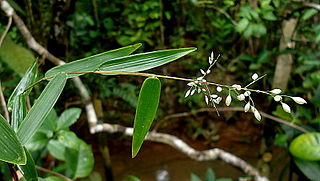
Parodiolyra is a genus of Neotropical plants in the grass family.
- Parodiolyra aratitiyopensisJ.R.Grande - Venezuela (Amazonas)
- Parodiolyra colombiensisDavidse & Zuloaga - Colombia (Caquetá)
- Parodiolyra lateralis(J.Presl ex Nees) Soderstr. & Zuloaga - Nicaragua, Costa Rica, Panama, Colombia, Venezuela, Guyana, Suriname, Ecuador, Peru, Brazil
- Parodiolyra luetzelburgii(Pilg.) Soderstr. & Zuloaga - Brazil, Colombia, Venezuela, Guyana, Suriname, French Guiana
- Parodiolyra micrantha(Kunth) Davidse & Zuloaga - Brazil, Colombia, Venezuela, Guyana, Suriname, French Guiana, Peru, Bolivia, Argentina, Paraguay
- Parodiolyra ramosissima(Trin.) Soderstr. & Zuloaga - Brazil (Bahia)

Bixa is a genus of plants in the family Bixaceae. It is native to Mexico, Central America, Caribbean, and South America, and naturalized in other places.

Sarcoglottis is a genus of flowering plants from the orchid family, Orchidaceae. It is widespread across much of Latin America from Mexico to Argentina, with one species extending northward into Trinidad and the Windward Islands.

Ischnosiphon is a genus of plants native to Central America, South America, Trinidad and the Lesser Antilles. It was first described as a genus in 1859.

Ludovia is a genus of plants first described as a genus in 1861. All the known species are native to Central and South America.
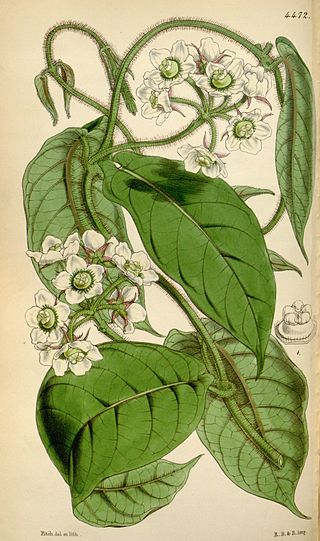
Fischeria is a plant genus in the family Apocynaceae, first described as a genus in 1813. It is native to South America, Central America, southern Mexico, and the West Indies.
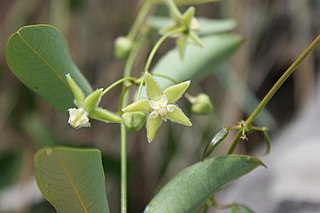
Blepharodon is a genus of plant in the family Apocynaceae, first described as a genus in 1844. They are native primarily to South America, with one species extending into Central America and Mexico.

Macroscepis is a genus of plants in the family Apocynaceae, first described as a genus in 1819. It is native to Latin America and the West Indies.

Dimerocostus is a group of flowering plants in the Costaceae described as a genus in 1891. It is native to Central and South America.




















